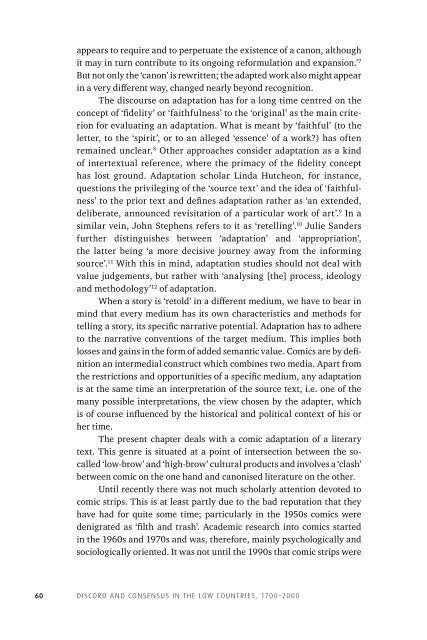Discord Consensus
7aze300jFJo
7aze300jFJo
You also want an ePaper? Increase the reach of your titles
YUMPU automatically turns print PDFs into web optimized ePapers that Google loves.
appears to require and to perpetuate the existence of a canon, although<br />
it may in turn contribute to its ongoing reformulation and expansion.’ 7<br />
But not only the ‘canon’ is rewritten; the adapted work also might appear<br />
in a very different way, changed nearly beyond recognition.<br />
The discourse on adaptation has for a long time centred on the<br />
concept of ‘fidelity’ or ‘faithfulness’ to the ‘original’ as the main criterion<br />
for evaluating an adaptation. What is meant by ‘faithful’ (to the<br />
letter, to the ‘spirit’, or to an alleged ‘essence’ of a work?) has often<br />
remained unclear. 8 Other approaches consider adaptation as a kind<br />
of intertextual reference, where the primacy of the fidelity concept<br />
has lost ground. Adaptation scholar Linda Hutcheon, for instance,<br />
questions the privileging of the ‘source text’ and the idea of ‘faithfulness’<br />
to the prior text and defines adaptation rather as ‘an extended,<br />
deliberate, announced revisitation of a particular work of art’. 9 In a<br />
similar vein, John Stephens refers to it as ‘retelling’. 10 Julie Sanders<br />
further distinguishes between ‘adaptation’ and ‘appropriation’,<br />
the latter being ‘a more decisive journey away from the informing<br />
source’. 11 With this in mind, adaptation studies should not deal with<br />
value judgements, but rather with ‘analysing [the] process, ideology<br />
and methodology’ 12 of adaptation.<br />
When a story is ‘retold’ in a different medium, we have to bear in<br />
mind that every medium has its own characteristics and methods for<br />
telling a story, its specific narrative potential. Adaptation has to adhere<br />
to the narrative conventions of the target medium. This implies both<br />
losses and gains in the form of added semantic value. Comics are by definition<br />
an intermedial construct which combines two media. Apart from<br />
the restrictions and opportunities of a specific medium, any adaptation<br />
is at the same time an interpretation of the source text, i.e. one of the<br />
many possible interpretations, the view chosen by the adapter, which<br />
is of course influenced by the historical and political context of his or<br />
her time.<br />
The present chapter deals with a comic adaptation of a literary<br />
text. This genre is situated at a point of intersection between the so-<br />
called ‘low-brow’ and ‘high-brow’ cultural products and involves a ‘clash’<br />
between comic on the one hand and canonised literature on the other.<br />
Until recently there was not much scholarly attention devoted to<br />
comic strips. This is at least partly due to the bad reputation that they<br />
have had for quite some time; particularly in the 1950s comics were<br />
denigrated as ‘filth and trash’. Academic research into comics started<br />
in the 1960s and 1970s and was, therefore, mainly psychologically and<br />
sociologically oriented. It was not until the 1990s that comic strips were<br />
60<br />
DISCORD AND CONSENSUS IN THE LOW COUNTRIES, 1700–2000


